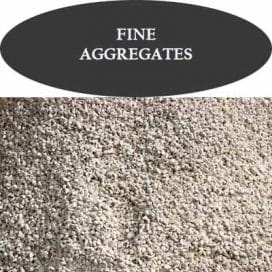Construction aggregate is a broad class of coarse-grained to medium-grained particulate material used in construction. It includes sand, gravel, crushed stone, slag, recycled concrete, geosynthetic aggregates, and even steel and carbon fiber aggregates in modern applications. Aggregates are among the most mined materials globally and form a key component of concrete and asphalt.
- DESCRIPTION OF AGGREGATE
- TYPES OF AGGREGATE
- CONSTRUCTION AGGREGATE PRICE
- DENSITY OF AGGREGATE
- USES OF AGGREGATE
DESCRIPTION OF AGGREGATE
Aggregate refers to a collection of non-metallic minerals in particulate form, used in civil and road engineering construction.
Aggregates are principally classified into 2 categories:
• Fine Aggregate.
• Coarse Aggregate.
TYPES OF AGGREGATE
Fine aggregate and coarse aggregate are two main types of aggregate.
Fine Aggregate

• Definition: Fine aggregates are small-sized filler materials used in construction.
• Size: Ranges from 4.75 mm to 0.075 mm.
• Materials: sand, surki, stone screenings, burnt clays, cinders, and stone dust.
• Sources: river sand, crushed stone sand, machine-manufactured sand (M-sand), and crushed gravel sand.
• Surface Area: High surface area.
• Function: Fills voids in concrete, improves finish.
• Uses: Mortar, plaster, concrete, road base layers, etc.
Coarse Aggregate

• Definition: Larger filler materials used in construction.
• Size: Greater than 4.75 mm.
• Materials: Stone chips, brick chips, gravel, pebbles, clinkers, recycled asphalt, and steel slag.
• Sources: Crushed stone, dolomite, natural disintegration of rocks.
• Surface Area: Lower than fine aggregate.
• Function: Provides volume and strength to concrete.
• Uses: Concrete, railway ballast, drainage beds, etc.
CONSTRUCTION AGGREGATE PRICE
• Average price in India (bulk supply): ₹450–₹750 per ton.
• M-sand average price: ₹700–₹1,100/ton (state-dependent).
• Recycled aggregates: ₹350–₹600/ton.
• Prices vary based on region, quality, and transport cost. Remove the outdated static price table and use this updated market range.
DENSITY OF AGGREGATE
Bulk and Relative density
i. Bulk Density:
The bulk density is the mass of an aggregate that is required to fill a container of a given unit volume.
Bulk Density = Mass/volume
Key Features:
• If the given volume is unity, then bulk density = mass.
• Unit—kg/m³ or lb/ft³
• In the above definition, the volume consists of both the aggregates and the voids which are between the aggregates
• The approximate bulk density is between 1200 and 1750 kg/m³.
ii. Relative Density:
The density (specific gravity) of aggregate is defined as the ratio of the mass of aggregate and mass of an equal volume of water
Relative Density = weight of the Aggregate/weight of an equal volume of water
Key Features:
• Most of the aggregate particles have a density within the range of 2.4-2.9, with a corresponding particle (mass) density of 2400-2900 kg/m³.
• The relative density of an aggregate can be found on an oven-dry basis or a saturated surface dry (SSD) basis
USES OF AGGREGATE
A) Uses of Aggregate in Concrete
• Increases the degree of concrete, so reduces the price. Aggregates account for 60-75% of the degree of concrete and 79-85% of the weight of PCC
• To give a rigid structure
• To cut back the shrinkage and cracking
• Concrete mixture is employed in several structures and substructures, e.g., completely different components of a building, bridges, and foundations.
• The smaller the aggregate size, the bigger its area, and also the additional binding material (cement) is going to be needed, leading to a better price
• The bigger the aggregate size, the larger are going to be, leading to wastage of binding material (cement)
B) Uses of Aggregates in Roads
• Stabilized treatment of building materials (blends of cement, fly ash, slag, lime)
• Stabilized with hydrocarbon materials (bitumen or tar)
• Stabilized with alternative materials (resins, fibers, geosynthetics, etc.)
• Recycled mixture
C) Uses of aggregate in Railway Ballast
• An absolutely loaded train weighs thousands of tons. To avoid injury to the rails, ground, and other close structures, a really robust aggregate is required to support this high weight
• Railway ballast usually consists of a tricky stone (crushed), like granite, with a bigger diameter varying between 30 mm and 50 mm. Particles finer than this diameter in higher proportion can cut back its drainage properties
• Some of the other uses are fills, backfills, drainage, and filtration applications
SUMMARY
Aggregate is employed in buildings and constructions and is additionally a fabric used for combining with cement, bitumen, lime, gypsum, or alternative adhesive to make concrete or mortar. The combination results in giving volume, stability, resistance to wear or erosion, and alternative desired physical properties to the finished product.

